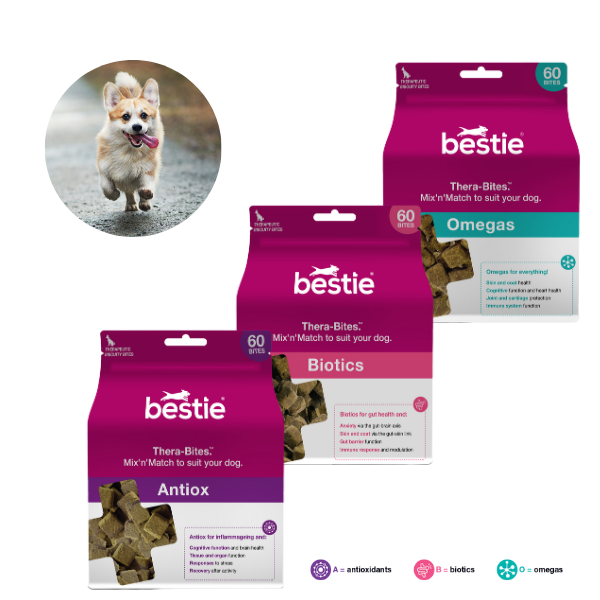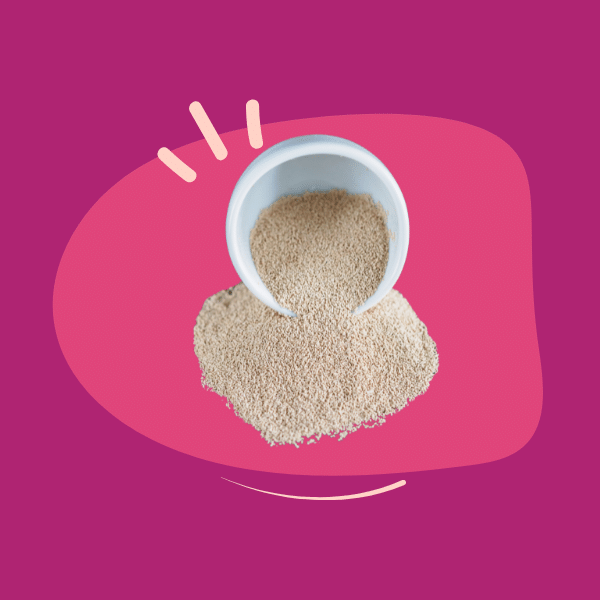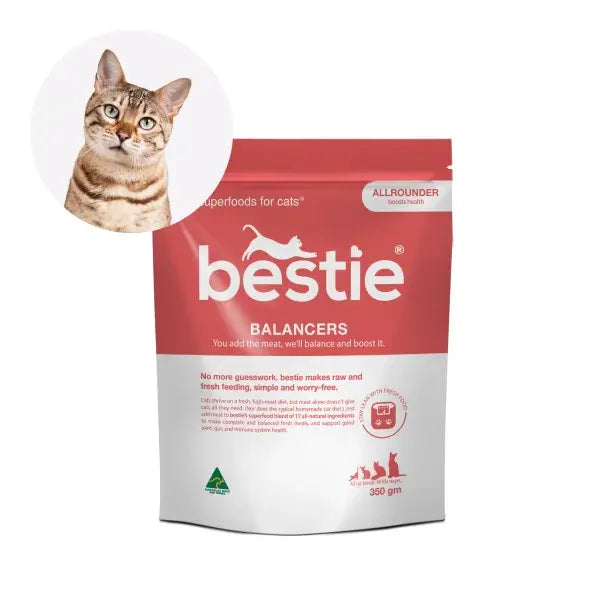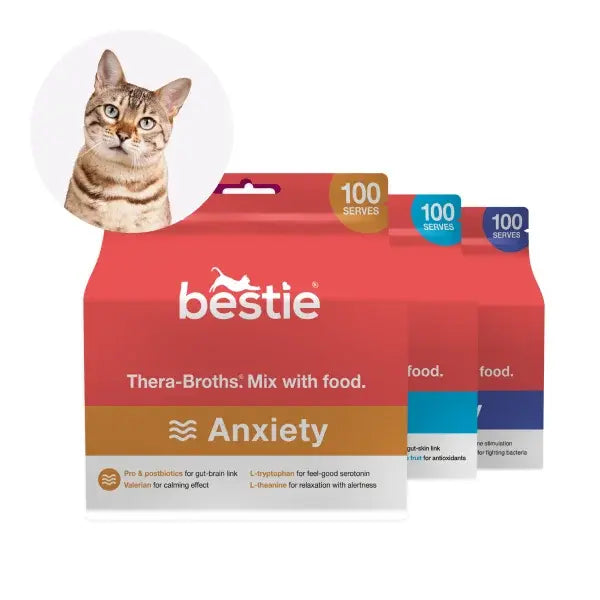If you’ve looked at the ingredients in our balancing supplement for cats, or our complete and balanced treats for dogs, you’ll have noticed that both include cricket protein. And, after you’re over the ‘ew’ factor, you may be wondering why that is…
Here, we explain why crickets are in the mix – how it compares to other ingredients and why it’s actually so green!
There are many of us, myself included, who are concerned about the environmental impact of the food we feed our dogs and cats[1]. There are good reasons why. In the US for example, dogs and cats:
- Consume about 19% (± 2%) of the amount of dietary energy that humans do and 33%( ± 9%) of the animal-derived energy.
- Produce about 30% (± 13%), by mass, as much poo as Americans.
- Constitute, through their diet, about 25–30% of the environmental impacts from animal production in terms of the use of land, water, fossil fuel, phosphate, and biocides.
- Are responsible for release of up to 64 ± 16 million tons CO2-equivalent methane and nitrous oxide, two powerful greenhouse gasses.
And that’s just in the US.
Compared to a plant-based diet, a meat-based dietrequires more energy, land, and water and has greater environmental consequences in terms of erosion, pesticides, and waste. In addition, protein is the most expensive macronutrient in ecologic and economic terms and therefore the one requiring the most attention with respect to sustainability[2].
This is a key reason that in our household, we switched to completely plant-based eating for ourselves, at the beginning of the year.
However, I am not prepared to do that for our dog, just yet. (The reasons why will be in another post.) However, I am very interested in learning about alternative protein sources, and it was this research that led me to look at crickets.
The protein factor
Dogs and cats need protein. It provides 10 essential amino acids for dogs: arginine, histidine, isoleucine, leucine, lysine, methionine, phenylalanine, threonine, tryptophan and valine. Cats need all those and they also have a dietary requirement for taurine.
Dogs and cats also need nitrogen and carbon for the synthesis of otherdispensable amino acids, gluconeogenesis and energy.
A note on why cats need taurine.
Taurine is a sulphur-containing amino acid that’s found in the most concentration within cardiac and skeletal muscle, but it’s been documented to a lesser extent in algae, bacteria, fungi and some higher plants. It plays multiple roles, including in the conjugation of bile acids, maintaining normal retinal and myocardial function, osmoregulation and modulation of calcium flux within cells as well as reproduction and immune response.
Low blood or plasma taurine concentrations in strict carnivores have been directly linked to retinal degeneration and cardiomyopathy, making taurine an essential amino acid for cats. However most other species (outside of felids and strict carnivores) can synthesise taurine from adequate dietary methionine and cystine.
All of this brings me to crickets. A group of researchers set up a study to evaluate the protein quality of a selection of insect species as potential ingredients for dog and cat foods.
They looked at:
- Housefly pupae (Musca domestica)
- Adult house cricket (Acheta domesticus)
- Yellow mealworm larvae (Tenebrio molitor)
- Lesser mealworm larvae (Alphitobius diaperinus)
- Morio worm larvae (Zophobas morio)
- Black soldier fly (Hermetia illucens) larvae and pupae
- Adult six spot roach (Eublaberus distanti)
- Adult death’s head cockroach (Blaberus craniifer)
- Adult female Argentinean cockroach (Blaptica dubia)
Reference substrates were:
- Poultry meat meal
- Fish meal
- Soyabean meal.
Substrates were analysed for, among other things, crude fat, ash and amino acid contents and for in vitro digestibility of organic matter (OM) and N.
(It’s worth noting that when we look at the quality of a protein, its quality can be predicted on the basis of its amino acid score. However, in reality, it may be of only poor quality because it’s poorly digested and/or absorbed. Therefore, when looking at protein quality, digestibility is important.)
When it came to crickets, not only did they contain the most crude protein, but both the crude protein content and amino acid score of house crickets were high and similar to that of fish meal, and much higher than poultry meat, but with higher in vitro nitrogen digestibility in both cases.
Other studies have demonstrated that crickets also contain taurine[3]. In fact, crickets, and a number of other insects in a separate study[4], yielded crude protein, essential amino acids and taurine concentrations in excess of the National Research Council’s maintenance requirement for cats.
But what about the green factor?
Well, the major environmental advantages[5] of insect farming compared to livestock production are:
- Less land and water are needed
- Greenhouse gas emissions are lower
- Insects have high feed conversion efficiencies
- Insects can transform low-value organic by-products into high-quality food or feed
Summing up, dogs and cats like it – our Crikkiesand bestie for cats are liked by most – it gives cats taurine, and it’s a sustainable protein source…what’s not to like? Oh! And when you cook it as Crikkies, it smells like chocolate…to most of us!
SOURCES
[1] Environmental impacts of food consumption by dogs and cats
Okin GS (2017) Environmental impacts of food consumption by dogs and cats. PLOS ONE 12(8): e0181301. https://doi.org/10.1371/journal.pone.0181301
[2] Swanson, Kelly & Carter, Rebecca & Yount, Tracy & Aretz, Jan & Buff, Preston. (2013). Nutritional Sustainability of Pet Foods12. Advances in nutrition (Bethesda, Md.). 4. 141-150. 10.3945/an.112.003335.
[3] Finke, Mark. (2002). Complete nutrient composition of commercially raised invertebrates used as food for insectivores. Zoo Biology. 21. 269-285. 10.1002/zoo.10031.
[4] McCusker, Sarah & Buff, Preston & Yu, Zengshou & Fascetti, Andrea. (2014). Amino acid content of selected plant, algae and insect species: A search for alternative protein sources for use in pet foods. Journal of nutritional science. 3. e39. 10.1017/jns.2014.33.
[5] Huis, Arnold & Oonincx, Dennis. (2017). The environmental sustainability of insects as food and feed. A review. Agronomy for Sustainable Development. 37. 10.1007/s13593-017-0452-8.





















